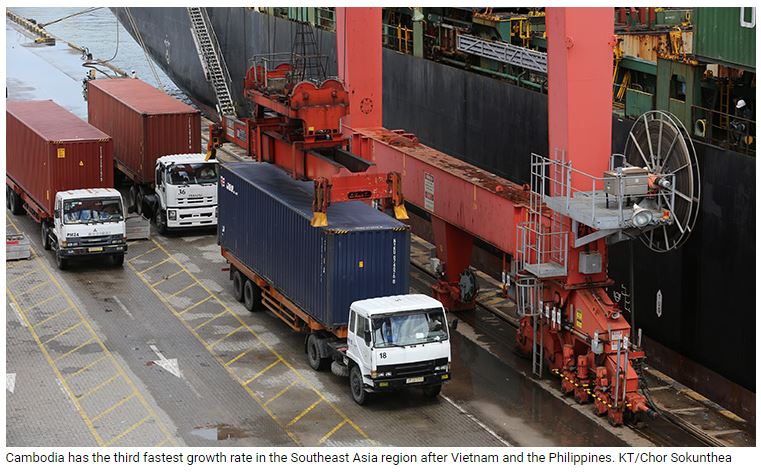WB sticks to Cambodia’s 5.2% growth forecast for 2023
World Bank has maintained the 2023 economic growth rate forecast for Cambodia at 5.2 percent while it lowered the prospects for the neighbouring countries Vietnam and Thailand from its October 2022 estimates.
Vietnam, which was expected to grow at 6.7 percent this year as per the October forecast will now grow by only 6.3 percent and Thailand only by 3.6 percent as against the earlier estimated 4.1 percent, according to the World Bank’s East Asia and Pacific (EAP) April 2023 Economic Update, released recently.
The forecast for Lao PDR has been revised marginally upward to 3.9 percent from 3.8 percent made in October, while that of Malaysia to 4.3 percent from the earlier 4.2 percent. Indonesia is expected to grow by 4.9 percent now as against the October forecast of 5.1 and the Philippines only by 5.6 percent as against the earlier predicted 5.8 percent.
Cambodia has the third fastest growth rate in the Southeast Asia region after Vietnam and the Philippines.
According to the World Bank report, growth in developing East Asia and the Pacific (EAP) is forecast to accelerate in 2023 as China’s economy reopens, while the pace of growth in most of the economies in the rest of the region is anticipated to ease after a strong rebound last year.
Economic performance across the region, while robust, could be held back this year by slowing global growth, elevated commodity prices, and tightening financial conditions in response to persistent inflation, said the report.
Growth in developing EAP countries is forecast to accelerate to 5.1 percent in 2023 from 3.5 percent in 2022, as China’s reopening helps its economy rebound to a 5.1 percent pace from three percent last year.
Growth in the region outside China is anticipated to moderate to 4.9 percent from the robust post-Covid-19 rebound of 5.8 percent in 2022, as inflation and elevated household debt in some countries weigh on consumption.
“Most major economies of EAP have come through the difficulties of the pandemic but must now navigate a changed global landscape,” said World Bank East Asia and Pacific Vice President Manuela V. Ferro. “To regain momentum, there is work left to do to boost innovation, productivity, and to set the foundations for a greener recovery.”
World Bank said earlier last week that across the world, a structural growth slowdown is underway and at current trends, the global potential growth rate is expected to fall to a three-decade low over the remainder of the 2020s.
“Nearly all the forces that have powered growth and prosperity since the early 1990s have weakened. The growth rates of investment and productivity are declining. The global labour force is aging and expanding more slowly. International trade growth is much weaker now than it was in the early 2000s,” the earlier report said.
However, it said that several economies in the EAP region such as Cambodia, Indonesia, Lao PDR, Malaysia, Myanmar, Papua New Guinea, and the Philippines are still enjoying a demographic dividend.
For Cambodia, Lao PDR, and Papua New Guinea, increases in working-age populations are expected, and these countries could continue to reap demographic dividends if they generate sufficient jobs, the report pointed out. The largest decline in the share of the working-age population is expected in China in the region.
Among the larger economies of the region, most, including Indonesia, the Philippines, and Vietnam, are anticipated to grow more modestly in 2023 than in 2022. Most Pacific Island countries are forecast to grow faster in 2023, but Fiji’s exceptionally strong economic pace in 2022 is likely to moderate.
Most countries in the EAP region have seen two decades of higher and more stable growth than economies in other regions. The result has been a striking decline in poverty and, in the last decade, also a decline in inequality.
However, the catch-up to the per capita income levels of advanced economies has stalled in recent years as productivity growth and the pace of structural reforms have slowed. Addressing the significant ‘reform gap,’ especially in services, could magnify the impact of the digital revolution and boost productivity in sectors from retail and finance to education and health.
The economies of the region must also cope with three important challenges as policymakers act to sustain and accelerate economic growth in the aftermath of Covid-19. Rising tensions between major trading partners will affect trade, investment, and technology flows across the region.
Finally, the region is particularly exposed to climate risks, in part due to the high density of population and economic activity along its coasts.
“De-globalization, aging, and climate change are casting a shadow over the growth prospects of a region that has thrived through trade and is growing old fast,” said World Bank East Asia and Pacific Chief Economist Aaditya Mattoo. “However, promoting trade, addressing population dynamics, and enhancing climate resilience could strengthen growth,” Mattoo added.
Source: https://www.khmertimeskh.com/501266499/wb-sticks-to-cambodias-5-2-growth-forecast-for-2023/


 English
English




